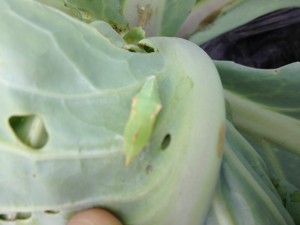VEGETABLES:
- Cole crops: Cabbage, Cauliflower and Broccoli: Imported cabbage worm numbers were over economic treatment thresholds in many late plantings. In addition, some broccoli plantings had flea beetles working on plants.
- High tunnel tomatoes: Early blight is present in many high tunnels, growers are encouraged to maintain a regular and consistent spray program. Yellow shoulder and blossom end rot, primarily abiotic conditions are also being noted by scouts. Damage by tomato hornworm was heavy in several high tunnels this week. Stink bugs, 2-spotted spider mites and aphids were also found by scouts this past week.
- Field tomatoes: Bacterial speck, spot and canker all being found on plants. In some plantings bacterial spot, speck, and canker are being found on the tomato fruit. Early blight and septoria leaf spot are found in many plantings. Blossom end-rot, and yellow shoulder are also being found. Stink bug numbers increased this past week and damage to fruit was noted.
- Sweet corn: Development stages range from some v7 for late planted corn to harvest on some plantings. Two corn earworm moths were found, one each at 2 different locations. Eastern corn borer moth trap counts increased this past week with a total of 15 moths recorded across 3 trapping locations. Fall armyworm feeding damage was seen in some fields but at levels below economic treatment threshold. In many fields, deer are a much bigger problem than insects or disease and in some fields birds are a significant pest as well.
- Cucumbers: Although no new downy mildew infections were found this past week, growers in the region should be on a protective spray program against downy mildew from now until the end of harvest. Harvest is under way in some plantings and there have been some plantings made for intended fall harvest. In many fields the bigger disease issue is powdery mildew and growers need to be managing with fungicides.
- Zucchini and Summer Squash: Cucumber beetle numbers increased to above treatment threshold levels this week in some plantings. Aphids were also noted on some plants. Angular leaf spot, anthracnose, phytophthora blight and powdery mildew are being found. Powdery mildew is really increasing and growers need to work at control of this disease. Some bacterial soft rot is being found where fruit has been damaged in previous handling.
- Winter Squash and Pumpkins: Cucumber beetle numbers in several plantings increased to above threshold numbers. Aphids were found at low levels on some plantings. Angular leaf spot, anthracnose, and powdery mildew are present in many plantings, with powdery mildew probably exhibiting the most disease pressure currently. Bacterial soft rot is showing up on plants that have had some handling damage or injury. Phytophthora blight can be found in some plantings. Insect-wise squash bugs increased to economic treatment levels in some plantings and stink bugs were also being noted by scouts. Scouts noted feeding damage by deer, groundhogs and racoons.
- Melons: Angular leaf spot, alternaria target spot, and phytophthora blight have been found. However, powdery mildew is currently the disease of most importance that growers need to control. Some cucumber beetle damage to melon fruit was noted.
- Potatoes: Some harvest of potatoes has started. Early blight was noted in some plantings. Colorado potato beetles (CPB) were heavy in some localized spots in some fields.
- Peppers: Bacterial spot and cercospora spot are being found in some plantings. Blossom end rot can also be found. A few plantings had fruit with bacterial soft rot. Some of the soft rot can be attributed to fruit damage caused by corn borer larvae. Aphids on some plants were noted by scouts.
- Eggplant: Anthracnose found on some plants. Phytophthora blight was identified on some eggplant fruit. Colorado potato beetles were above treatment threshold levels in some plantings. Stink bugs and grasshoppers were also noted by scouts.
- Green/Snap Beans: Beans generally look very good, some light defoliation by Japanese beetles was noted by scouts in some plantings.

